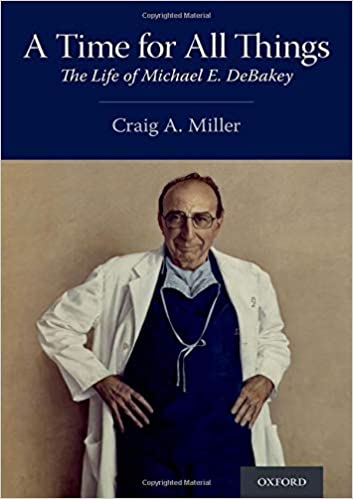Arpan K. Banerjee
Solihull, UK

Cover of A Time for All Things. The Life of Michael E. DeBakey by Craig A. Miller.
In the latter half of the twentieth century, Michael DeBakey was a worldwide household name, a remarkable feat for a surgeon in the days before the cult of celebrity had become part of the cultural zeitgeist. Craig Miller, himself a distinguished vascular surgeon and medical historian, has written a superb scholarly and readable biography on arguably one of the most famous cardiac surgeons of the twentieth century. The book has been extensively researched. The author interviewed old colleagues of DeBakey and had access to the extensive DeBakey archives in Houston and the National Library of Medicine, including letters and photographs, making this work a comprehensive summary of this remarkable man. The text is extensively referenced with footnotes and photographs and includes an extensive index.
Michael DeBakey, of Lebanese descent, was born in 1908 in the USA. He attended Tulane University Medical School and there developed a version of the roller pump that later became an important part of the heart-lung machine and would enable open heart surgery to be performed more safely. Having completed his first research thesis on stomach ulcers, he completed his surgical training in Europe, working with Leriche in France and Kirschner in Germany. He returned to work at Tulane and was one of the earliest doctors to suggest an association between smoking and lung cancer in 1939 along with Oschner, his teacher, and later confirmed by Sir Richard Doll in the United Kingdom. During World War II he helped develop Mobile Army Surgical Hospital units (MASH), popularized in subsequent military conflicts.
In 1948 he moved to Houston, Texas, where he developed vascular and cardiac surgery services at the Baylor College of Medicine. The book covers in detail his many accomplishments during that period. He was one of the first to use Dacron grafts to repair arteries and aortic aneurysms and pioneered surgery for aortic dissections. In 1953, he did one of the earliest carotid endarterectomies. He pioneered cardiac bypass surgery and cardiac valve surgery and later made inroads into artificial cardiac assist devices with Denton Cooley, his famous collaborator from 1951 until 1969.
DeBakey eventually became Chancellor of the University, serving from 1979-1996.
The biography covers in detail DeBakey’s life and career, including his relationships with colleagues. His reputation as a hard taskmaster is borne out by his old trainees (several of whom later became leaders in their fields), but his striving for excellence and doing the best for his patients was his motivating factor. His work ethic was remarkable—he only slept five hours a night. He published over 1,500 articles and received many honors during his long life, including the Albert Lasker Award in 1963, the Presidential Medal of Freedom in 1969, and fifty honorary degrees. He was also an adviser on health matters to several presidents.
In his late eighties, he was called in by Russian cardiac surgeons to supervise the bypass operation on President Boris Yeltsin.
It seems ironic that DeBakey developed an aortic dissection in 2005, a disease whose treatment he had pioneered. He died in 2008 aged ninety-nine years.
This biography is an important historical work of scholarship. It chronicles DeBakey’s remarkable life and surgical contributions and is also a history of the pioneering days of heart surgery. Today we take many of these cardiac procedures for granted. These advances and improved safety techniques were only made possible by the remarkable skills, bravery, and persistence of the great pioneering men and women of the last century.
A Time for All Things. The Life of Michael E. DeBakey
Craig A. Miller
OUP 2020 610 pages
ISBN 9780190073947
ARPAN K. BANERJEE, MBBS (LOND), FRCP, FRCR, FBIR, qualified in medicine at St. Thomas’s Hospital Medical School, London. He was a consultant radiologist in Birmingham from 1995–2019. He served on the scientific committee of the Royal College of Radiologists 2012–2016. He was Chairman of the British Society for the History of Radiology from 2012–2017. He is the Treasurer of ISHRAD and adviser to Radiopaedia. He is the author/co-author of numerous papers and articles on a variety of clinical medical, radiological, and medical historical topics, and seven books, including Classic Papers in Modern Diagnostic Radiology (2005) and The History of Radiology (OUP 2013).

Leave a Reply